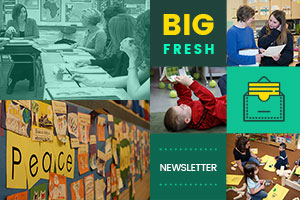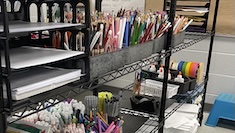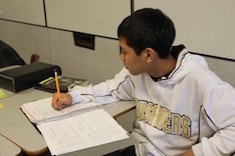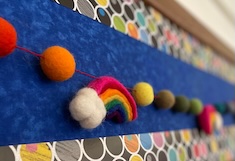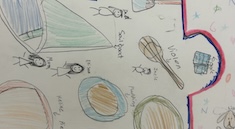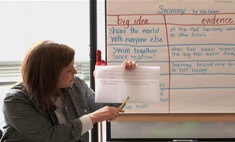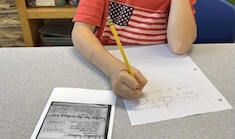Library
Choice Literacy Articles & Videos
The Choice Literacy library contains over 3,000 articles and 900 videos from 150+ contributors. Classic Classroom and Literacy Leadership subscribers have access to the entire library. Content is updated continuously, with five to six new features published each week.
Latest Content
August 22, 2025: Welcoming Everyone!
This week’s newsletter is about creating a classroom community that positions students to learn.
Classroom Tour: Creating and Living a Classroom Charter
In a classroom tour, Mandy Robek offers a wise approach to developing a classroom vision with her students. They begin by discussing the way they would like to feel in the classroom. Then they determine the actions that will help them feel those ways. Finally, they make a plan for what to do when they don’t feel supported in the classroom.
Purposeful Ways to Incorporate Interactive Writing at the Start of the Year
One of the instructional methods we love the most in primary classrooms is interactive writing. It allows us to target the needs of our learners as individuals and reinforce the phonics rules we’ve been studying whole-class, builds community by co-creating something together, and gives us a chance to use our learning in real, authentic, and purposeful ways. Tara Barnett and Kate Mills offer simple ways you can use interactive writing to co-create your classroom space with your students.
Talking Back: A Strategy for Annotation
Tiffany Abbott Fuller gives us everything we need to use an active reading strategy. By the time you finish reading this article, you’ll be prepared to teach this strategy, equipped with sentence stems for students, specific ideas for instruction, and an anchor chart for visual reference.
Hidden Lessons: Are We in Control of Who We Become? (Part 4)
In this final installment of the “Hidden Lessons” series, Gretchen Schroeder turns to perhaps the most complicated question of all: To what extent are we in control of who we become? It’s a question that touches on issues of identity, personal responsibility, outside influence, and human nature, all of which are especially relevant during adolescence. Gretchen includes another booklist to support this conversation.
Classroom Tour: Classroom Supplies
In a classroom tour, Mandy Robek offers a unique and powerful approach to community supplies in her classroom.
Authentic Audiences for Writing in School
Our student writers deserve to have authentic audiences. Tara Barnett and Kate Mills share two opportunities for authentic peer audiences for finished writing pieces in school. Finding space and time for student writing to be seen and heard by their peers in meaningful ways is essential.
Writing in the Wild: Bringing Back Authenticity
Vivian Chen offers big and small ways to make writing instruction more authentic and engaging for your students.
Hidden Lessons: Why Do Relationships Matter? (Part 3)
By the time they reach high school, many students have learned how to survive change, but not always how to make sense of it. They’ve lost friendships, switched schools, experienced family transitions, or even dealt with grief. While they may not always talk openly about these experiences, they often find reflections of them in the books they read. Gretchen Schroeder continues her series about using literature to help students learn important social and relationship skills. She includes student work and a booklist.
Classroom Tour: Flexible Seating
Mandy Robek shares a variety of seating choices students have in her classroom. She explains the reason for her choices and how she manages a classroom where no one has an assigned seat.
I Am a Listener Who…
Melissa Quimby challenged herself to unpack her identity as a teacher who listens. She discovered clear and repeatable actions that all educators can use to be intentional listeners. Schools become safer spaces when students feel heard. What new things might you try to create a safer space for children?
Building Trust in Our Classrooms
Tara Barnett and Kate Mills remind us that more important than the physical layout of the classroom or the assessments we’ll give is the type of community we’ll become. Building a brave and enthusiastic community of learners is the foundation that everything else stands on. They share a community-building experience that can be adapted for any age.
August 15, 2025: Positive Approaches to Change
This week’s newsletter is about ways to keep a positive attitude toward change.
Wheels: Adapting to Change on the Roller Derby Track and in Your Teaching Life
Gwen Blumberg is inspired by a challenging roller derby practice and sees parallels for teachers who are facing challenging situations with changes to literacy curriculums. If something is shifting in your life, this article is sure to offer you confidence in moving forward.
Walking a Teaching-Readers Tightrope: Finding Balance Between Beliefs and Expectations
Hannah Tills offers a much-needed metaphor for all teachers who are implementing a new curriculum resource. Rather than thinking of the new expectations as part of a pendulum, Hannah encourages us to think of walking a tightrope. She offers ways to stay rooted in student engagement, student access, student choice, and teacher autonomy while also meeting expectations of a newly adopted curriculum program.
Classroom Tour: Manipulatives and Books
In a classroom tour, Mandy Robek shares the thoughtful ways she pairs math manipulatives and books while providing easy access to the tools for students. She also promotes engineering and design with access to building blocks and parts.
Hidden Lessons: How Do We Cope with Challenges and Change? (Part 2)
Literature gives students a safe space to learn about struggle, resilience, and emotional growth without requiring personal vulnerability. Gretchen Schroeder offers a way to focus students’ independent reading to explore coping with challenges and change in life. You won’t want to miss the included young adult booklist. This is the second installment of a series.
August 8, 2025: Anchor Charts
This week’s newsletter is about anchor charts.
An Ode to the Anchor Chart
In a world where anchor charts are becoming digitized and developed by curriculum publishers, Bitsy Parks reminds us of the power and importance of co-creating anchor charts with students. She outlines key steps and ways to adjust anchor charts to connect with students and improve engagement.
Four Ways to Use Anchor Charts in the Classroom
Tiffany Abbott Fuller provides a practical and fresh approach to organizing anchor charts in meaningful and helpful ways. Don’t miss the action-oriented summary at the end of the article to put these ideas into place in your classroom.
Classroom Tour: Kinds of Spaces to Help Learning Blossom
Mandy Robek takes time to consider different places students will use in the classroom. She considers books, portable learning spaces, and the way learning will blossom over time in her third-grade classroom.
Hidden Lessons: Integrating Social-Emotional Learning in an Authentic Way
We know there is a need to teach more lessons about wellness, and we know that it is sometimes difficult to teach those lessons in a way that students will accept. Gretchen Schroeder offers three questions for teachers to consider as they plan to incorporate social and emotional learning standards into their classrooms. This is the first installment of a series.
August 1, 2025: Simple Joys
This week’s newsletter is about simplifying the start of the school year.
Books Are My Management Strategy
Becca Burk reflects on the power of reading as a way to set routines and help nourish healthy regulation.
Creating a Space
Gwen Blumberg clearly outlines different kinds of spaces for our classrooms and libraries. She was inspired by David Thornburg’s Learning Space model where he suggests creating campfires, watering holes, and caves to support different kinds of learning.
July 25, 2025: Let’s Get Started
This week’s newsletter is about getting started with the new school year.
June 27, 2025: Restore, Refresh, Rejuvenate
This week’s newsletter is about inspiring renewal.
June 20, 2025: Choice Numeracy
This week’s newsletter highlights Choice Numeracy.
June 13, 2025: Generative AI (Part II)
This week’s newsletter is about generative AI.
June 6, 2025: Generative AI (Part I)
This week’s newsletter is about generative AI.
Browse Content By
Type
Category
- Assessment Tools
- Big Fresh Archives
- Booklists
- Choice Numeracy
- Classroom Design
- Common Core
- Community Building
- Conferring
- Content Literacy
- Digital Literacy
- English Language Learners
- Equity
- Family Relations
- Free Samples
- Guiding Groups
- Leadership
- Literacy Coaches
- Mentor Texts
- Minilessons
- New Teacher Mentors
- Podcasts
- Poetry
- Quote Collections
- Reading Strategies
- Self Care
- Struggling and Striving Learners
- Talking and Listening
- Teacher Study Groups
- Teaching Reading
- Teaching Writing
- Word Study and Vocabulary
Author
- Melissa Quimby
- Nawal Qarooni
- Gwen Blumberg
- Julie Cox
- The Lead Learners
- Hannah Tills
- Josie Stewart
- Ruth Metcalfe
- Mallory Messenger
- Becca Burk
- Jodie Bailey
- Vivian Chen
- Mary Brower
- Tiffany Abbott Fuller
- Stephanie Affinito
- Ruth Ayres
- Leigh Anne Eck
- Heather Fisher
- Shari Frost
- Julie Johnson
- Suzy Kaback
- Gigi McAllister
- Shirl McPhillips
- Melanie Meehan
- Cathy Mere
- Debbie Miller
- Tara Barnett and Kate Mills
- Tammy Mulligan
- Dana Murphy
- Bitsy Parks
- David Pittman
- Brenda Power
- Heather Rader
- Matt Renwick
- Mandy Robek
- Christy Rush-Levine
- Gretchen Schroeder
- Jen Schwanke
- Brian Sepe
- Katherine Sokolowski
- Stella Villalba
- Jennifer Vincent
Grade Level
Choice Literacy Membership
Articles
Get full access to all Choice Literacy article content
Videos
Get full access to all Choice Literacy video content
Courses
Access Choice Literacy course curriculum and training

